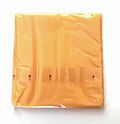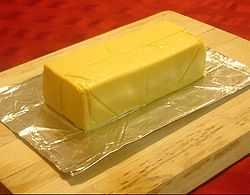Processed cheese
Processed cheese is a dairy product. It is made from cheese. Other unfermented dairy products, emulsifiers, salts, food colorings and whey may be added to this.
History
The first processed cheese was made by Walter Gerber in Thun, Switzerland in 1911. Today, this is still sold as Gala. The first processed cheese in Germany was made by Gebrüder Wiedemann, in 1922. This was named Adler (which is German for Eagle). At approximately the same time, Fromageries Bel launched La vache qui rit, which is still available today. In Austria, it was Alma, in 1921.
Advantages and disadvantages
There are a number of advantages of processed cheese over regular cheese. These are:
- Processed cheese has a longer shelf-life
- It is possible to use leftovers from other cheesemaking processes.
- The melting process can be controlled better. Regular cheese often separates into fat, and proteins.
- There are fewer flavors of processed cheese than of unprocessed cheese
One disadvantage to processed cheese is that it is unhealthier than other cheeses if eaten too much.[1]
Processed Cheese Media
Cheese spreads, such as this one from the Netherlands, may be considered processed cheese in the broad sense
American cheese is a processed cheese. Pictured here in a single wrapped slice.
A gift pack containing several varieties of labeled process cheese. Upper left: a "pasteurized process cheese food" and a "pasteurized processed cheese spread" Upper center: a "pasteurized process cheese spread Havarti-type flavor" Lowermost right: a "pasteurized process cheese food with jalapeño peppers"
Government cheese from 2023: a large chunk of American pasteurized process cheese and a small chunk of processed Cheddar cheese
Easy Cheese, a "pasteurized process cheese snack" (unregulated term), on a pretzel
Velveeta, a "pasteurized prepared cheese product" (unregulated term)
Cheez Whiz, a "cheese dip" (unregulated term) commonly used for cheesesteaks
References
- ↑ Delany, Alex. "What Is Processed Cheese, and Should We Eat It?". Bon Appétit. Retrieved 2021-05-12.








